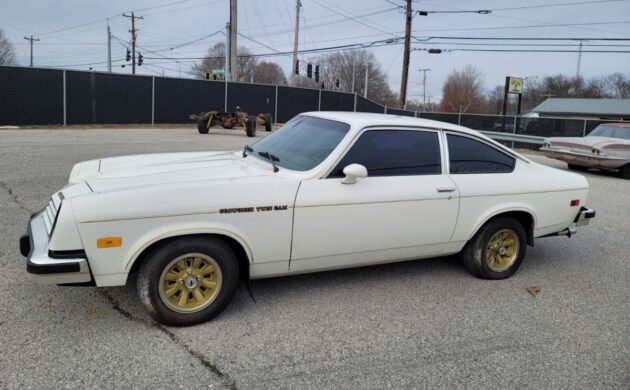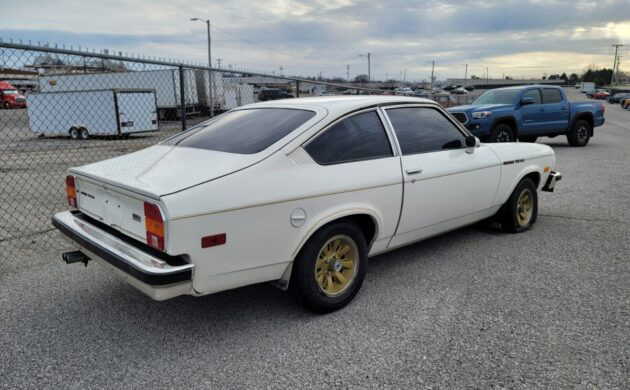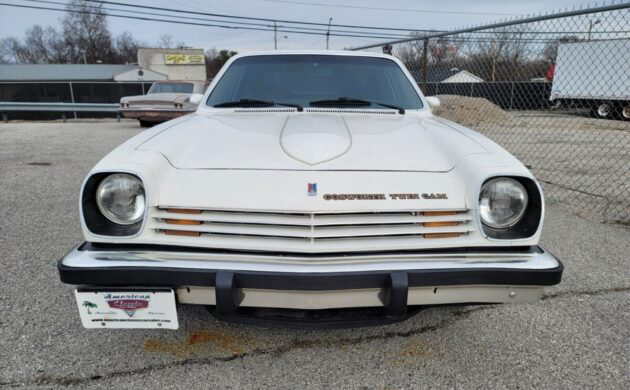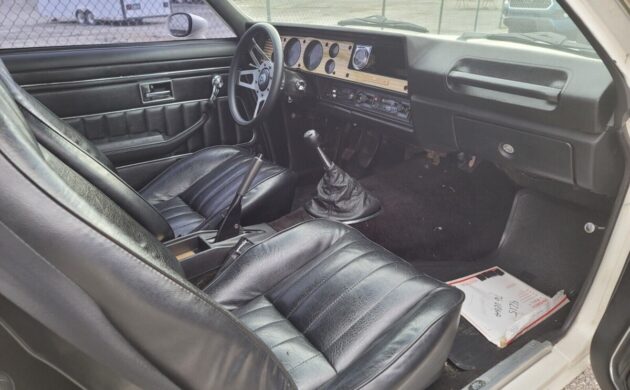The latter half of the 1970s was a period not known for a lot of memorable U.S. automobiles. Build quality was usually suspect and whatever performance they once had was deterred by tightened emissions controls. And don’t forget that the age of cheap gasoline had come and gone. The Chevy Vega was built during this period and – it, too – was a forgettable car, except for the Cosworth Vega of 1975-76. This one has been dormant for the last seven years and may come back to life with some TLC. Located in Bowling Green, Kentucky, this ‘70s bright light from Chevrolet is available here on eBay where the bidding stands at $5,500.
Vega was Chevrolet’s first subcompact intended to thwart the growing market shares of imports from Europe and Japan. More than two million of them were produced from 1971-77, but the car was beset with quality control problems, premature rust, and overheating engines that quickly gave the auto a black eye. Rising gas prices after the 1973 OPEC oil embargo may be what kept the car afloat for as long as it did. Hoping to change things around, Chevrolet decided to release a limited edition, performance-oriented version of the Vega that had an engine co-developed with British motorsport experts Cosworth Engineering.
The Cosworth Vega didn’t stand out physically from other Vega’s. No spoilers, splitters, or scoops could be found anywhere. What did make it stand out was the special motor under the hood. Chevy and Cosworth collaborated for several years on developing this engine. They took the standard Vega inline-4 that displaced 140 cubic inches and de-stroked it to 122. And equipped it with tougher internals, a heat-treated, forged steel crankshaft, and race-grade forged aluminum pistons and connecting rods. Cosworth adapted the head design, which also featured 16 valves per cylinder and twin cams with aggressive profiles that were actuated by individual gears located on the front end. It was rated at 110 hp.
Across just two model years, 3,508 Cosworth Vega’s materialized, with 1,447 in 1976, the year of the seller’s car. Perhaps the car’s reputation was the reason why they didn’t sell. Rumor has it that 5,000 blocks were produced, and the rest were dumped when the project came to a close. Another reason for slow sales was that the Cosworth Vega was only $900 cheaper than a Corvette. The seller’s ’76 Cosworth comes in Antique White, the only year the color was available on the car, as well as the 5-speed manual.
We’re told this Chevy was sitting indoors for seven years before being rolled outside a few weeks ago. The engine cranks on the recently installed new battery, but the seller has made no other attempts to get it running. The body looks good, especially for a Vega, and the paint’s not bad, either, a likely repaint. The interior also shows no abnormal wear for being 47 years old. The tires are all ancient and need to go and one doesn’t hold air for very long. We don’t know why this car was mothballed, but with luck maybe it can be back on the road fairly soon. The seller provides additional photos and a video to help in the review.







There is white overspray on the tire, so maybe a quick/cheap paint job. Weird gray primer on inside hatch panel? Non running and rust seems to be lurking a little. Needs to be bought cheap. The Weber conversion is a strong positive.
best
bt
Looks like mold and dirt on the tires from sitting for 7 years not paint..
16 valves per cylinder? No wonder these were so expensive! (I know it’s just a simple mistake, but I can’t resist.)
Beat me to it..
ALL Vegas are forgettable, I fixed enough of those turds back in the day, don’t need any bad reminders of an otherwise great time in my life.
They should give this to the scrap metal place. Or better yet pay them when they drop it off. That will save them money in the long run
ha ha. yes, I was going to pick on the 16-valves-pre-cylinder slip too.
Can’t help feeling that this model was a disappointment, a missed opportunity. A top class race engine developer involved, an engine with many of the right design features to support really high performance, but my understanding was that the productionized version they actually sold was barely any more powerful than the standard Vega 4-cylinder? hardly surprising that it was not a runaway success, at that price.
Also, being based on a model that was already a flop, with a very negative reputation, wouldn’t have helped.
We are talking different ratings. The Vega made 110 horsepower Advertized while the Cosworth made 110 horsepower SAE net as installed. Before you think big deal? The 350 Chevy V8 was only rated at 160 horsepower SAE Net installed in the Corvette.
The weak link like all cars of the same era was the EFI. It really took an expert with access to a lot of test equipment to fix any problem. It does not have the OBD2 that came out in the late 90’s. Making trouble shooting very complex. ( and you have to wonder about parts availability with do few made) finally, while it’s self adjusting, it’s designed for leaded gasoline with no oxygenation. Plus, any modifications fueling will remain at original specifications.
As far as Webers being an answer, yes and no!!!! Webers are magnificent! If you know how to tune them and are willing to buy all the air correction meters, idle jets, chokes, main jets, you need.it’s easy to spend a few thousand dollars for a complete set.
Yes you can have someone get it close. But with every single weather change, air density change, humidity change, the engine will be either too rich or worse too lean. I have a properly calibrated air density meter and after about 3 hours on a chassis Dyno I could probably get them close. Then before you use the car check the air density to see if you need to make adjustments.
Yes you can just drive it. Unless you’re racing, 10-15 horsepower more or less probably doesn’t mean anything. Just don’t to go too lean.
Cardboard engine. I was towed several times.
Chevy was way behind the 8ball.on this car…had they only developed a v6 iron block 260 inch motor..these things would have lasted.in a vega..or maybe contracted with Mazda a v6 motor for the car..man Ed Cole and gm.only knew how to make gorilla caddys that weigh.5000lbs.and 460 motors..no wonder they were going broke.
A bit of a hyperbole to throw the whole of the Vega story on Ed Cole — management, engineering and labor all had a role in how that played out.
And to summarize the man’s influence as the Vega program and outsized 70s Cadillacs??? I can’t recall a 460 inch GM engine as referenced, but a number of displacements — ranging from 265 through 400 — come to mind, and that engine family has a lot of Ed Cole DNA in it.
Man I had one in yellow and it was a lemon I bought for $400 back in 1986 boy what a mistake
$6,600 now, not as bad as some.
A no-hit body with a 4 speed from the 70’s? I’m relieved it survived opinions like those above for all this time. Now it can go to someone who cares. I had a regular Vega in the 80’s. Someone had swapped in an Iron Duke. I liked it just fine, and sold it to a neighbor because his offer was so good.
Scrap the original engine and drop in a mildly built 327 and a serpentine belt system with headers, spring-loaded Hurst four-speed, a nice carburetor, a 342 12 bolt posi and you’ll have a blast driving this car.
Oye… Carbs… This is an admission by someone at some point that “I’m too dumb to figure out what’s wrong with the fuel injection”. Heck, I got my Cosworth Vega back in the early 80’s simply for that reason! “That’s one of dem dare fuelly-jection ingines!” Still, I teach classes in fuel and ignition and we spend 5 whole minutes on carbs. Carburetors, as a necessary part of their design, RESTRICT THE AIR GOING INTO THE ENGINE. OK..we are done now….
Cosworth initially designed the engine with dual side draft Webers and the engine output was rated at 180 HP. Unfortunately that setup was not EPA emissions compliant so the fuel injection system was incorporated into the design.
Currently some if not many of the fuel injection components are not available so this was in fact a wise move for reliability and probable power increase.
The fuel injected engine was down 40 HP at 140 HP.
It is not the fuel injection that is responsible for the “power loss”. It is the fact that it was the engine being set up for emissions (and drivability) which causes it to have a lower output. Compression ratio and cam profile are the “power makers”. Valve sizes and air flow (intake and exhaust systems) play a big part. Things like the manifold cross section working with cam profile determines where the torque is developed. Modern cars have variable intake systems to address this. Look at it this way. Both the carbs and the FI system have to produce a proper mixture. Sure, it’s likely that the FI system was setup to be on the lean edge of combustion (tho not so lean you get huge amounts of NOx) The carb is likely set up richer just for the reason that there’s no compensation for temperature or air density. HOWEVER..once you go to full throttle, the FI system goes to “power” setting and goes to a mixture that makes the most power. The EPA doesn’t test emissions at WOT. You now have unrestricted air airflow with the exact mixture to make power. Putting carbs on THAT ENGINE will not produce any more power. The 180 hp engine is NOT the engine that went into the production car. We don’t know, but it is very likely the 180 hp engine was highly “peaky” and made power only between 6500 and 7000 rpm and fell on its face anywhere other than that., Think “full race cam” and how well those engines pull away from a stop sign. Leaving the FI on the car would mean better mileage, emissions and power.
There’s another old expression “Pearls before swine”.
So, with that in mind, I will happily stop posting. Saves me time and effort and the bandwidth for everyone . Peace, out!
steve…
Scary to know that a person who knows nothing about carburetors “teaches” about them. I feel sorry for your students.
Dave, thanks for a laugh! I was going to respond with a list of my credentials (43 years as an ASE master tech really is meaningless) but it’s the student that counts. They are all hired BEFORE graduation. In many cases, when it comes up that they’ve studied under me, the next question is “When can you start?!”
It’s real simple. Carbs have a venturis which restricts airflow. Less air means less fuel which means less heat which equals less expansion pressure which equals less power. Add to that the fact that that there is no way for a carb to make adjustments for temperature, air density and the like and you have a loser. THAT is something you can relate to, eh?
And for God’s sake, stay off commercial airliners! Only one of my degrees is automotive related. It seems I’m the guy who certified the fire suppression system on your aircraft. If you want to discuss how density altitude and humidity impact engine mass airflow, I’m up for it. Study up! My white paper on the subject is at the FAA tech center.
Those who can and know will
Many who can’t will teach..
That’s a really old saying..
Steve, the venturi effect is not a restriction. The air speeds up thru the venturi. Of course a carb cant adjust itself, who doesnt know that? I’m responding to a carb being a restriction to airflow. You apparently have fooled alot of clueless of folks with your BS, but I aint buyin any.
Maury,
Please explain how your comment relates to the car listed? All you’ve done is manage to take a swipe at all teachers with some super duper clever invective, so you’ve clearly not learned much from……anyone, ever?
BT
Steve, as a former instructor who taught both digitally and in person, I didn’t pick up my papers and walk away from the podium when those to whom I was speaking, didn’t get the message. I just continued to re-state the message until I reached them and it became evident that they “got it.” I would encourage you to try doing the same here, especially since many of us are likely to not have the same level of understanding you do about the function of air/fuel induction to an internal combustion engine. We are not “swine”. We are simply like-minded people who may be in search of that information from a knowledgeable source. So please try to be that if you can.
I had a black and gold ’76 a couple years ago. Had to do the top end because a prior owner had installed the timing belt too loose and it jumped a cog, tagged a valve. After doing all that work and making improvements it still was a huge disappointment. All show and no go, got rid of it as fast as I could.
I think to make real performance (assuming it was stock), you’d need to increase both compression and lift/duration (it already comes stock with a really nice stainless tubular header!. These were depowered from the test stage in order to meet emissions – that’s what killed power output, and that’s what was most likely in your car.
Still, as an earlier poster said, I think the body design was great. I have one in the shop, was working on it last night….
cheers,
bt
The weakest point of all Vega engines was the aluminum block that had no iron sleeves or the equivalent of today’s Nikasil cylinder coatings.
Oil consumption was terrible.
Iron Duke transplants were popular because of the excessive oil consumption.
The second weakest point was the ability of the cowl to dissolve due to poor drainage and air circulation.
Two of these abominations the same day…
Watching Mecum now in Kissimmee, a black 75 just sold for $26k.
There’s a sucker born every minute!
Replace the drivetrain with the components I specified above and you’ll surprise many a Mustang and Camaro at the stop light. My brother did it!
It should be noted the power and influence GM had over the government, media and general public. With everything going their way in the early 1970’s had the world by the ass. They had money and power and were their own standard.
With all this you would think they would have been the FIRST company to make a car to compete with Japan. This is what GM lead the public to believe was the car to own. Their total influence with Peterson Publishing was a given the award for car of the year. Clearly shows they were in bed with the media.
Who else at the time could make junk and hype it and price it $50 less than their flagship sports car. One that only made a few horsepower more than their entry level car. Everyone was duped. The only people that enjoyed the Vega was the Japanese. They also loved the Citation, Diesels and the 4/6/8 Cadillacs.
Put a small block Chevy in a vega and blow the doors off big blocks . I did to a 1976 bi centennial paid $300. For the car and $100.00for a 69 Impala 250 hp ,it was fun and dangerous, sold it for $3500.00 in 1978.